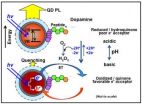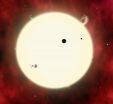(Press-News.org) INDIANAPOLIS – Technologies for rapid detection of bacterial pathogens are crucial to maintaining a secure food supply.
Researchers from the School of Science at Indiana University-Purdue University Indianapolis (IUPUI) and the Bindley Bioscience Center at Purdue University have developed a novel approach to automated detection and classification of harmful bacteria in food. The investigators have designed and implemented a sophisticated statistical approach that allows computers to improve their ability to detect the presence of bacterial contamination in tested samples. These formulas propel machine-learning, enabling the identification of known and unknown classes of food pathogens.
The study appears in the October issue of the journal Statistical Analysis and Data Mining.
"The sheer number of existing bacterial pathogens and their high mutation rate makes it extremely difficult to automate their detection," said M. Murat Dundar, Ph.D., assistant professor of computer science in the School of Science at IUPUI and the university's principal investigator of the study. "There are thousands of different bacteria subtypes and you can't collect enough subsets to add to a computer's memory so it can identify them when it sees them in the future. Unless we enable our equipment to modify detection and identification based on what it has already seen, we may miss discovering isolated or even major outbreaks."
To detect and identify colonies of pathogens such as listeria, staphylococcus, salmonella, vibrio and E. coli based on the optical properties of their colonies, the researchers used a prototype laser scanner, developed by Purdue University researchers. Without the new enhanced machine-learning approach, the light-scattering sensor used for classification of bacteria is unable to detect classes of pathogens not explicitly programmed into the system's identification procedure.
"We are very excited because this new machine-learning approach is a major step towards a fully automated identification of known and emerging pathogens in real time, hopefully circumventing full-blown, food-borne illness outbreaks in the near future. Ultimately we would like to see this deployed to tens of centers as part of a national bio-warning system," said Dundar.
"Our work is not based on any particular property of light scattering detection and therefore it can potentially be applied to other label-free techniques for classification of pathogenic bacteria, such as various forms of vibrational spectroscopy," added Bartek Rajwa, Ph.D., the Purdue principal investigator of the study.
Dundar and his colleagues believe this methodology can be expanded to the analysis of blood and other biological samples as well.
INFORMATION:
This study was supported by a grant from the National Institute of Allergy and Infectious Diseases.
Co-authors of "A Machine-Learning Approach to Detecting Unknown Bacterial Serovars" study in addition to Dundar and Rajwa are Ferit Akova, a graduate student at the School of Science at IUPUI, and Purdue University researchers V. Jo Davisson, E. Daniel Hirleman, Arun K. Bhunia, and J. Paul Robinson.
Eat safer: Novel approach detects unknown food pathogens
2010-10-17
ELSE PRESS RELEASES FROM THIS DATE:
New beam source for Brookhaven accelerators
2010-10-17
UPTON, NY - A new source of ions will soon be the starting point for the beams entering two major research facilities at the U.S. Department of Energy's (DOE) Brookhaven National Laboratory - the Relativistic Heavy Ion Collider (RHIC - http://www.bnl.gov/rhic), where physicists are recreating conditions of the early universe to learn more about the forces that hold matter together, and the NASA Space Radiation Laboratory (NSRL: http://www.bnl.gov/medical/NASA/NSRL_description.asp), where scientists study the effects of space radiation to help find ways to protect astronauts. ...
Focus on dementia
2010-10-17
Alzheimer's disease is not the only type of dementia. Two particular forms are dementia with Lewy bodies and Parkinson's disease dementia. In both forms, the diagnosis is of vital importance because the treatment for these dementias differs from that for Alzheimer's dementia, as Brit Mollenhauer and co-authors explain in the dementia theme issue of Deutsches Ärzteblatt International (Dtsch Arztebl Int 2010; 107[39]: 684-91).
In more than 75% of patients, the memory impairments are due to Alzheimer's disease. In Lewy body dementia, which is accompanied by cognitive and/or ...
NRL scientists unravel complex quantum dot-dopamine interactions
2010-10-17
Scientists at the Naval Research Laboratory (NRL) in conjunction with the Scripps Research Institute in La Jolla, Ca., recently reported a detailed study of the interactions of water soluble semi-conductor quantum dots (QDs) with the electro-active neuro-transmitter dopamine. These biocompatible QD-dopamine nano-assemblies may be used as the active component for sensors that are used to detect a wide variety of target analytes ranging from sugars to peroxides.
According to NRL's Dr. Michael Stewart, a member of the research team "The nature of the QD-dopamine ...
Squid studies provide valuable insights into hearing mechanisms
2010-10-17
The ordinary squid, Loligo pealii—best known until now as a kind of floating buffet for just about any fish in the sea—may be on the verge of becoming a scientific superstar, providing clues about the origin and evolution of the sense of hearing.
In a hangar-like research building at the Woods Hole Oceanographic Institution (WHOI), biologist T. Aran Mooney is exploring virtually uncharted waters: Can squid hear? Is their hearing sensitive enough to hear approaching predators? How do squid and other marine species rely on sound to interact, migrate, and communicate? Will ...
Study confirms: Whatever doesn't kill us can make us stronger
2010-10-17
BUFFALO, N.Y. -- We've all heard the adage that whatever doesn't kill us makes us stronger, but until now the preponderance of scientific evidence has offered little support for it.
However, a new national multi-year longitudinal study of the effects of adverse life events on mental health has found that adverse experiences do, in fact, appear to foster subsequent adaptability and resilience, with resulting advantages for mental health and well being.
The study, "Whatever Does Not Kill Us: Cumulative Lifetime Adversity, Vulnerability and Resilience," to be published in ...
Right foods aid memory and protect against disease
2010-10-17
For the first time researchers have found out what effect multiple, rather than just single, foods with anti-inflammatory effects have on healthy individuals.
The results of a diet study show that bad cholesterol was reduced by 33 per cent, blood lipids by 14 per cent, blood pressure by 8 per cent and a risk marker for blood clots by 26 per cent. A marker of inflammation in the body was also greatly reduced, while memory and cognitive function were improved.
"The results have exceeded our expectations! I would like to claim that there has been no previous study ...
Missouri Botanical Garden researcher discover new genus
2010-10-17
An article published in the October issue of the Annals of the Missouri Botanical Garden describes a new genus of tree of the Aptandraceae family, a group that is related to the sandalwoods (order Santalales). The genus, which has been given the name Hondurodendron, is endemic to Honduras and means "tree of Honduras."
In the article, "Hondurodendron, a New Monotypic Genus of Aptandraceae from Honduras," lead author Dr. Carmen Ulloa, associate curator at the Missouri Botanical Garden, and co-authors
Dr. Daniel L. Nickrent, Southern Illinois University-Carbondale, Dr. ...
How to weigh a star using a moon
2010-10-17
How do astronomers weigh a star that's trillions of miles away and way too big to fit on a bathroom scale? In most cases they can't, although they can get a best estimate using computer models of stellar structure.
New work by astrophysicist David Kipping says that in special cases, we can weigh a star directly. If the star has a planet, and that planet has a moon, and both of them cross in front of their star, then we can measure their sizes and orbits to learn about the star.
"I often get asked how astronomers weigh stars. We've just added a new technique to our toolbox ...
Images shed new light on inflammation
2010-10-17
Calgary, AB - Researchers at the University of Calgary Faculty of Medicine are using an innovative new imaging technique to study how white blood cells (called neutrophils) respond to inflammation, and have revealed new targets to inhibit the response.
When the body is invaded by infection, the immune system counters by generating inflammation with deployment of white blood cells to the site of danger to kill invading bacteria. However, inappropriate inflammation occurs in the absence of infection when tissues are damaged, and this inappropriate response contributes ...
Beauty is in the eye of the beholder the world over
2010-10-17
Western culture is increasingly obsessed with physical appearance and beauty, but vanity is nothing new, nor is it limited to just one culture. Moreover, differences in our perception of physical beauty have an enormous impact on the fashion, cosmetics, and weight control industries, and more recently on aesthetic surgery trends. Understanding how culture and region alter the perception of beauty is therefore not only of anthropological and social interest but underpins multibillion dollar industries across the globe.
According to Anil Mathur of Hofstra University in ...



